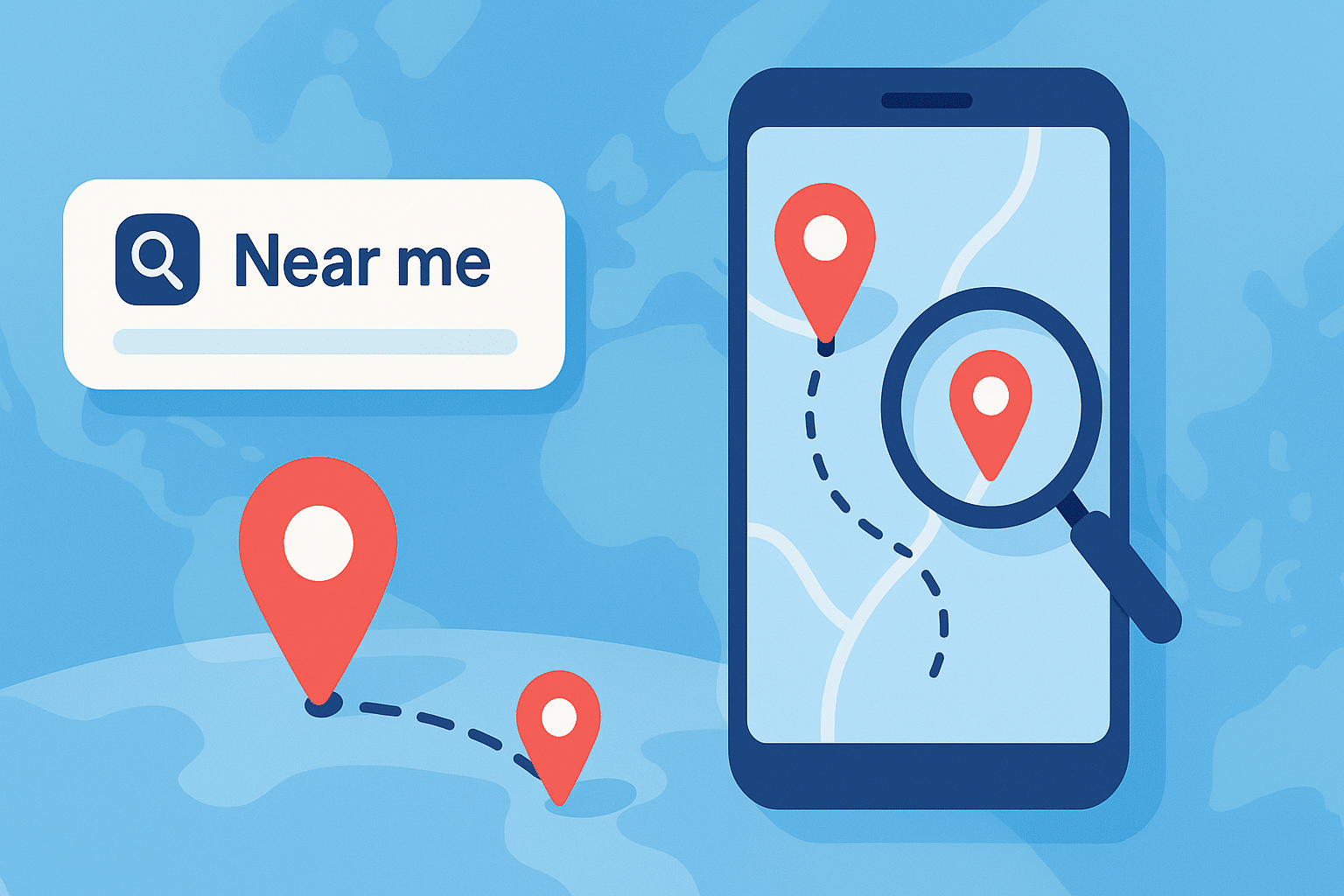Proximity factor in SEO means how near things are, either in real space or in written content. It affects two areas: geographic proximity and keyword proximity. The first shows local businesses close to the searcher. The second helps rank pages when keywords appear close together in a sentence or query.
In search, proximity factor helps search engines decide what to show first. If someone types “coffee shop near me,” the engine checks how close the shop is to the user. That is geographic proximity. If someone searches for a long phrase, like “affordable SEO company,” and those words are placed close together in content, it boosts the page’s chance to rank. That is keyword proximity.
Both types aim to match what the user needs right now. But proximity alone is not enough. Search engines also look at relevance, content quality, and online trust. Still, when used with other signals, proximity factor helps content rank higher for local SEO and long-tail queries.
Geographic proximity in local search results
Geographic proximity means how near a business is to the person searching. In local SEO, this is one of Google’s top three ranking signals, along with relevance and prominence. When someone searches for a local service, Google checks the distance between the user and possible business listings.
How Google measures distance
Google uses GPS, IP address, or a typed location to find the user’s position. In a non-geomodified search, like the dentist near me, it guesses the location from the device. In a geomodified search, like a dentist in Pune, it focuses results on that area. For both, businesses closer to the user usually appear higher, if other factors are equal.
Why it matters for search visibility
Proximity helps show results that are nearby and useful. For example, when someone searches a coffee shop, Google often shows the 3-pack, or map box, with nearby shops. A business close to the user can get seen more often. This helps small shops with good location rank better even if they have fewer reviews.
When proximity is not enough
Being nearby is helpful, but not the only factor. If a further business is more relevant or more trusted, Google may still rank it higher. For example, if someone looks for a 24-hour pharmacy, and only one shop is open late, it may show up even if it is five miles away.
How the Vicinity update changed things
In late 2021, Google released the Vicinity Update, which increased the weight of geographic closeness in local search. After this, businesses very close to searchers ranked higher more often, even beating some better-rated places that were farther away.
How to improve ranking despite distance
A business cannot change its address easily, but it can still improve visibility:
- List an accurate address on the Google Business Profile
- Keep business hours and contact info updated
- Add services and target keywords to improve local relevance
- Build positive reviews, local links, and mentions to grow prominence
- Open more branches in high-search areas if possible
Example of proximity in real use
If someone in south Delhi searches for a 24-hour clinic, Google will first try to find one nearby. If a clinic one kilometre away is open all night, it will likely appear. But if none are close, a further clinic that is open will be shown. A clinic 30 kilometres away, though, will rarely appear unless there are no better options nearby.
Keyword proximity in SEO content
Keyword proximity means how close keywords are to each other in written content. In SEO, it helps search engines understand if a page closely matches a search query. When words appear together or in the same order as the query, proximity is high.
Why keyword proximity affects rankings
Search engines check how tight or scattered keywords are in a sentence. For example, the phrase used in fantasy books has strong proximity when all three words are placed side by side. A sentence like Best Used Fantasy Books to Read gives a clear signal of exact match. But a sentence like We stock used novels and fantasy books splits the idea, making it harder for the search engine to link it to the query.
How search engines process word distance
Modern algorithms still look at text distance between keywords, though they also use natural language processing (NLP) to understand meaning. Google’s BERT model, for instance, can interpret variations, but strong keyword proximity still helps pages rank for long-tail keywords and exact match queries.
Best practices for keyword proximity
Writers can improve keyword proximity by following these tips:
- Use exact phrases when they fit naturally
Good: This guide covers electric scooter safety tips
Poor: Tips for people learning to ride electric scooters safely - Avoid extra words between keywords
Better: Proper use of seat belts
Weaker: Effective and proper use of seat belts - Keep natural word order
Users search for coffee bean grinder, not grinder coffee bean - Focus on readability first
Do not overuse phrases just to increase proximity. Forced use reduces clarity. - Use related words to avoid repetition
For example, combine car, automobile, and vehicle naturally when talking about the same topic.
Keyword proximity works with other on-page SEO factors like:
- Keyword prominence: where the term appears (title, first paragraph)
- Keyword density: how often it is used
- Semantic relevance: if the page content fits the query meaning
Together, these help search engines decide how well a page matches a multi-word search.
Even if keywords are not tightly grouped, a well-written page with helpful content can still rank. But for very specific queries, tight proximity may offer a ranking edge by showing a clear topic match.
Reference
- https://support.google.com/business/answer/7091?hl=en
- https://lawrank.com/relevance-proximity-prominence-breaking-down-googles-local-seo-ranking-factors/
- https://www.seo.com/blog/keyword-density-prominence-and-proximity/
- https://www.ignitingbusiness.com/blog/what-is-the-proximity-bias-factor-in-google-search-and-how-does-it-impact-seo-search-engine-optimization
- https://www.searchenginejournal.com/ranking-factors/relevance-distance-prominence/
- https://en.ryte.com/wiki/Keyword_Proximity/


